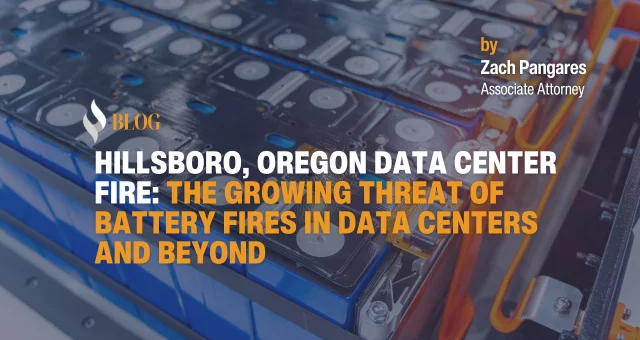
On Thursday, what began as a routine morning at the Hillsboro data center outside of Portland, Oregon turned into a five-hour battle against burning lithium-ion batteries that reveals critical gaps in how we regulate and prepare for the toxic risks posed by large-scale battery facilities.
The Hillsboro facility, reportedly leased by Elon Musk’s X for data storage including servers and networking infrastructure, became the site of a dangerous lithium fire on May 29. Fire crews were ultimately forced to abandon direct suppression efforts, instead working to contain the perimeter while allowing the battery bank to burn itself out.
The thick, toxic smoke and the fire's resistance to traditional suppression methods highlight a troubling reality: lithium-ion battery fires don't behave like ordinary fires, and our emergency response systems aren't adequately prepared for them.
Rapid Expansion, Minimal Oversight
The rapid expansion of battery storage facilities is reshaping the energy landscape across the United States, especially in states like California and Oregon that are leading the shift toward renewable energy. Data centers, electric vehicle charging stations, and large-scale battery storage sites are being built at a remarkable pace. However, this swift development often overlooks the potential toxic risks these facilities may pose to surrounding communities.
While the intention is positive, the regulatory frameworks governing these facilities are woefully inadequate. Many are approved through standard industrial permitting processes that don't account for the unique fire and toxic exposure risks posed by large concentrations of lithium-ion batteries. For example, a facility storing even small quantities of ammonia or chlorine gas must undergo extensive environmental impact assessments, maintain detailed emergency response plans, and comply with rigorous federal oversight under the Clean Air Act. Yet, massive battery storage facilities capable of releasing hydrogen fluoride and heavy metals often receive approval through routine commercial zoning processes with minimal safety review.
Current battery storage facility approvals often fail to address the specialized equipment and protocols necessary to handle battery fires safely.
The Moss Landing Disaster: A Preview of What's Coming
Unfortunately, the Hillsboro fire isn't an isolated incident. Just months ago, the Moss Landing battery storage facility in California experienced a fire suppression failure that should have served as a warning to the entire industry. Our firm represents the Moss Landing community in litigation stemming from that disaster, and the parallels are striking.
Schools closed, major roads shut down, and agricultural operations ground to a halt as a toxic plume spread across Monterey County and beyond. The fire and toxic plume of smoke deposited ash, soot, and heavy metals throughout surrounding communities and into the ocean.
Subsequent soil sampling revealed toxic metal levels up to 1,000 times higher than normal up to a mile from the facility. The fire smoldered for days before re-igniting on February 18th, a full month later.
The Science Behind the Lithium-ion Fires
Lithium-ion batteries don't simply burn. Internal short circuits, overcharging, and extreme temperatures can cause thermal runaway: a chain reaction that generates intense heat and toxic gases while proving extraordinarily difficult to extinguish, especially on large scales. These fires release hydrogen fluoride and other acidic fluorine gases that can scar lungs, burn skin, and even etch glass. The heavy metal particles from battery fires can drift for miles, contaminating soil and posing long-term risks to surrounding communities and ecosystems.
Health risks from lithium-ion fire exposure:
- Respiratory distress: heightened asthma, irritated airways, difficulty breathing, pulmonary edema, and lung collapse
- Skin and eye irritation: including burns, cuts, pains, redness, and itching
- Neurological effects and nerve damage
- Hearing loss
- Poisoning from the chemicals that can lead to nausea, dizziness, weakness, and even be life-threatening
- Long-term effects, including chronic respiratory issues and increased risks of lung disease from prolonged or repeated exposure
Environmental impacts: - Soil and water contamination from debris, residual materials, battery chemicals, and extinguishers
- Air quality: Smoke from the fire can carry particulate matter and toxic gases, leading to respiratory irritation and other health problems for locals and animals
Elon Musk: Corporate Accountability and Technological Recklessness
From individual Tesla crashes that result in toxic battery fires on public roadways to massive data center installations housing thousands of the same volatile batteries, Musk's companies have repeatedly demonstrated a pattern of prioritizing innovation speed over comprehensive safety testing and public welfare.
At Singleton Schreiber, attorney Brett Schreiber is currently representing multiple lawsuits against Tesla regarding its self-driving features, which allegedly malfunctions and leads to severe injuries and fatalities. Compounding the danger, many Tesla crash cases result in lithium-ion battery fires from the vehicles' power systems, creating additional hazards for victims, first responders, and nearby communities.
The Hillsboro Data Center's connection to Elon Musk's business empire illustrates corporate negligence and the systematic deployment of dangerous lithium-ion battery technology without adequate safety measures.
A Pattern of Technological Overreach
Lithium-ion battery systems pose fire and toxic exposure risks at both individual and industrial scales, but communities are treated as test subjects while these technologies lack proper safeguards. The Hillsboro Data Center is located just a mile from residences and schools, with popular destinations like Topgolf, Liberty High School, and the Hillsboro Hops Stadium, all downwind from the facility. Similarly, the Moss Landing facility was constructed in a rural community where residents had little political power to oppose its placement.
Whether its autonomous vehicles tested on public roads or massive battery facilities being constructed near schools and residential areas, there is a disturbing pattern of companies prioritizing technological advancement and profit over public safety.
Singleton Schreiber Leads the Fight Against Corporate Negligence
Singleton Schreiber has established itself as the premier law firm in the country for wildfire litigation and emerging catastrophic fire-related cases. Our comprehensive understanding of fire science and the complex causation issues in catastrophic fire cases sets us apart. Whether the ignition source is utility equipment, battery storage facility thermal runaway, or corporate negligence, our team has the technical expertise to hold responsible parties accountable. As emerging technologies like large-scale battery storage create new fire risks, we're developing innovative legal strategies to address these threats.
With a dedicated team of approximately 450 staff members and over 120 attorneys, Singleton Schreiber has the resources to take on the most complex corporate defendants. We fight not just for financial compensation, but for accountability measures that prevent future tragedies.
If you or your community have experienced negative health impacts from battery storage facilities, data centers, or other industrial operations, contact Singleton Schreiber today for a free consultation.
- Associate Attorney
Zachary Pangares is an Associate Attorney at Singleton Schreiber, where he focuses on Fire Litigation and complex civil matters. A skilled trial lawyer, Zachary brings a strategic, client-centered approach to litigation ...

